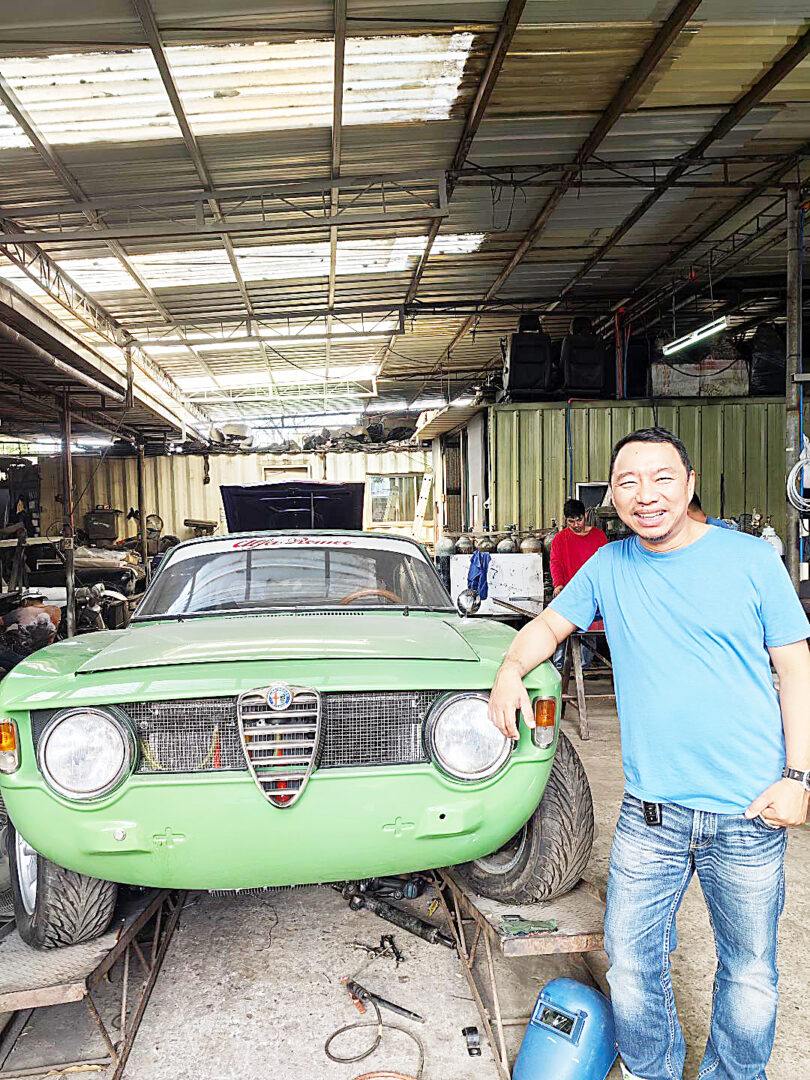Ronald Araga was busy working on two projects one fine afternoon in his nondescript shop in Caloocan City that also houses his steelwork business.
The 54-year-old resto-mod expert was currently working on a 1969 Alfa Romeo junior and a 1964 Chevy Impala which owners wanted to use as daily drivers.
These vintage cars can be usually found in a museum or the junkyard, but somehow ended up in the hands of people who find joy and fulfillment in driving old, classic four-wheel vehicles.
Yes, some people prefer old cars restored to top condition than those coming fresh from the factory. Never mind if the cost of restoration is sometimes bigger than buying a brand-new car.
“Look, if you are in a parking lot full of modern cars and you find a car that your late grandfather drove, which do you think will get more attention?” Araga asked.

Araga, however, is not into full restoration, a long tedious process that includes finding period-correct parts and accessories.
He’s more into making cars driveable with modern parts and technology while keeping the classic look. It is something that gets him into an endless debate with purists.
“What is the use of restoring a car that you can’t use regularly?” he would always ask his critics.
Araga has been at it for over three decades. He made his first resto-mod when he was 21 — a Mini Cooper with a Honda engine.

“I sold it to a Japanese. At that time, it was the most expensive Mini Cooper,” he recalled.
Araga, who took up computer engineering, said it normally takes six months on average to complete the resto-modding.
“I can only complete between four and six cars in a year,” he said, using a team of six craftsmen, including mechanics and tinsmiths.


Unless being insisted upon, Araga said he would rather have their resto-mods painted by other shops.
“There are customers who are hard to please when it comes to painting. Even when you thought that you did a good job, they will always find a way to find defects,” he explained.
Araga belongs to a family that was the first jeep builders of Navotas Jewels, a stainless stamping plant that catered to stainless fabrication.
“We usually do jeep parts and specialize in tube bending and metal shaping. We were the pioneers in stainless in the Camanava region before the seventies,” he said, adding that his grandfather and father were great mechanics.
“So I grew up accustomed to building jeeps and their mechanicals.”


Although he had planned to go to Don Bosco to learn automotive, Araga said he realized that it was better to learn it through experience.
The Alfa Romeo has already been turned over to its owner.
Agara said it retained the original engine with Twin Webber 48, and did body works and painting.
He said they installed a three-row aluminum radiator, a converted rack and pinion, and electric power steering. The alternator was upgraded to 125 amperes.
The car also had a modern brake booster, lightened clutch master and foot pedal, an in-tank gas tank with race-style filler, upgraded wiring, multi-groove main pulleys, an upgraded water pump, and twin SPAL fan setup for the radiator.
Araga said so far, the Alfa Romeo drives like a dream.
“Because it now has the rack and pinion system, it has precise steering so parking is a breeze. Cooling and shifting are much better. It was only the engine that was old tech,” he said.
About the Impala, it will undergo a chassis swap procedure.
“Reverse engineering,” he said. “We got a Toyota Majesta 1997 Crown with a 2JZ engine. Removed the body and retained the chassis.”
Araga said the creature comforts and Japanese reliability were adapted to the Impala. The modifications include using the column shift.
“So with all these modern inputs got into a 64, you bet all is sweet,” he said.
Despite the fulfillment it brings, resto-modding does not pay much, according to Araga.
“Our steelwork business is still the one that brings food to the table,” he said.
Also inside his shop were five mini Coopers waiting to be resto-modded.
“The owners are not much in a hurry. They got tired of high prices for parts so they are getting Japanese reliability,” he said.
Aside from mini Coopers, Araga also specializes in old Ford Escorts, mostly the Mexico model, using the platform of the first-generation, rear-wheel Mazda Miata.
There were two Miatas in the shop — a donor car and the other whose modified front bumper was to be replaced with the original.
Ford Escorts are rarely seen on the streets nowadays with most owners preferring to keep than sell them on the market.
If ever you see one, most likely, it has gone into Araga’s resto-modding.
He had long wanted to do a Ford Escort for his ride but his last two attempts ended elsewhere.
This time, however, Araga swears that his ongoing project would be for keeps.
He showed the body shell of the Escort made by hand except for the roof for six months using galvanized iron.
“Galvanized has metal protection and coating while the original car metal sheets need to be dipped in rust protection and are usually being used in volume production,” he said.
Ironically, despite his passion for resto-modding cars, Araga’s daily drivers are a commuter van and a sports utility van.
“These days, the only time I drive a classic car is when I test drive it,” he said.
